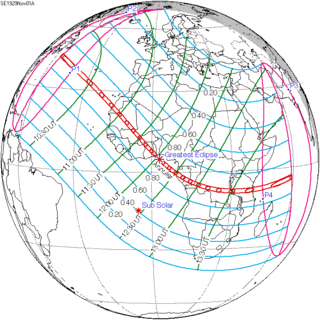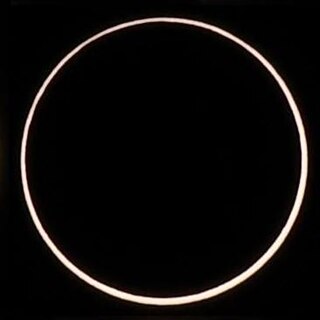
An annular solar eclipse occurred on September 1, 2016. A solar eclipse occurs when the Moon passes between Earth and the Sun, thereby totally or partly obscuring the image of the Sun for a viewer on Earth. An annular solar eclipse occurs when the Moon's apparent diameter is smaller than the Sun's, blocking most of the Sun's light and causing the Sun to look like an annulus (ring). An annular eclipse appears as a partial eclipse over a region of the Earth thousands of kilometres wide. In this case, annularity was observed in Gabon, Congo, Democratic Republic of the Congo, Tanzania, Mozambique, Madagascar, and Reunion.

An annular solar eclipse occurred at the Moon's descending node of the orbit on December 4, 1983. A solar eclipse occurs when the Moon passes between Earth and the Sun, thereby totally or partly obscuring the image of the Sun for a viewer on Earth. An annular solar eclipse occurs when the Moon's apparent diameter is smaller than the Sun's, blocking most of the Sun's light and causing the Sun to look like an annulus (ring). An annular eclipse appears as a partial eclipse over a region of the Earth thousands of kilometres wide. Annularity was visible in Cape Verde, Annobón Island of Equatorial Guinea, Gabon, the People's Republic of Congo, Zaire, northern Uganda, southern Sudan, northwestern Kenya, Ethiopia and Somalia. The Sun's altitude was 66°. Occurring 6.5 days before apogee, the Moon's apparent diameter was near the average diameter.
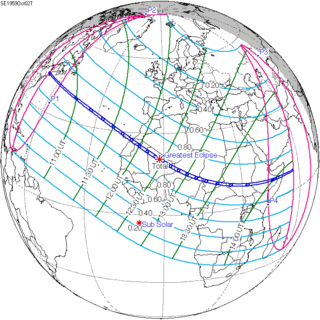
A total solar eclipse occurred on October 2, 1959. A solar eclipse occurs when the Moon passes between Earth and the Sun, thereby totally or partly obscuring the image of the Sun for a viewer on Earth. A total solar eclipse occurs when the Moon's apparent diameter is larger than the Sun's, blocking all direct sunlight, turning day into darkness. Totality occurs in a narrow path across Earth's surface, with the partial solar eclipse visible over a surrounding region thousands of kilometres wide. Totality was visible from northeastern Massachusetts and the southern tip of New Hampshire in the United States, Canary Islands, Morocco, Spanish Sahara including the capital city Laayoune, French Mauritania, Mali Federation, French Niger, British Nigeria, British Cameroons and French Cameroons, French Chad including the capital city Fort-Lamy, French Central Africa, Sudan, Ethiopia, and the Trust Territory of Somaliland.
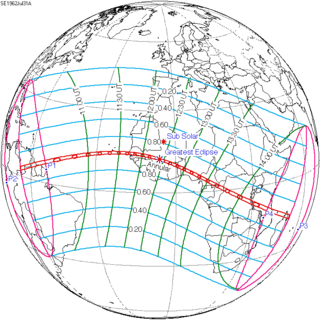
An annular solar eclipse occurred on July 31, 1962. A solar eclipse occurs when the Moon passes between Earth and the Sun, thereby totally or partly obscuring the image of the Sun for a viewer on Earth. An annular solar eclipse occurs when the Moon's apparent diameter is smaller than the Sun's, blocking most of the Sun's light and causing the Sun to look like an annulus (ring). An annular eclipse appears as a partial eclipse over a region of the Earth thousands of kilometres wide. Occurring only 4.7 days before apogee, the Moon's apparent diameter was larger. This solar eclipse occurred 44 days after the final game of 1962 FIFA World Cup.
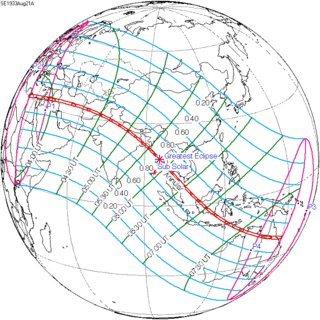
An annular solar eclipse occurred on August 21, 1933. A solar eclipse occurs when the Moon passes between Earth and the Sun, thereby totally or partly obscuring the image of the Sun for a viewer on Earth. An annular solar eclipse occurs when the Moon's apparent diameter is smaller than the Sun's, blocking most of the Sun's light and causing the Sun to look like an annulus (ring). An annular eclipse appears as a partial eclipse over a region of the Earth thousands of kilometres wide. Annularity was visible from Italian Libya, Egypt, Mandatory Palestine including Jerusalem and Amman, French Mandate for Syria and the Lebanon, Iraq including Baghdad, Persia, Afghanistan, British Raj, Siam, Dutch East Indies, North Borneo, and Australia.
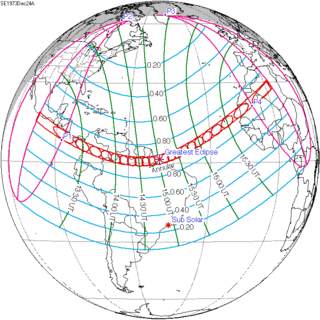
An annular solar eclipse occurred on December 24, 1973. A solar eclipse occurs when the Moon passes between Earth and the Sun, thereby totally or partly obscuring the image of the Sun for a viewer on Earth. An annular solar eclipse occurs when the Moon's apparent diameter is smaller than the Sun's, blocking most of the Sun's light and causing the Sun to look like an annulus (ring). An annular eclipse appears as a partial eclipse over a region of the Earth thousands of kilometres wide. Annularity was visible from southern Mexico, southwestern Nicaragua, Costa Rica including the capital city San José, Panama, Colombia including the capital city Bogotá, southern Venezuela, Brazil, southern Guyana, southern Dutch Guiana, southern French Guiana, Portuguese Cape Verde including the capital city Praia, Mauritania including the capital city Nouakchott, Spanish Sahara, Mali, and Algeria.

An annular solar eclipse occurred on December 14, 1955. A solar eclipse occurs when the Moon passes between Earth and the Sun, thereby totally or partly obscuring the image of the Sun for a viewer on Earth. An annular solar eclipse occurs when the Moon's apparent diameter is smaller than the Sun's, blocking most of the Sun's light and causing the Sun to look like an annulus (ring). An annular eclipse appears as a partial eclipse over a region of the Earth thousands of kilometres wide.
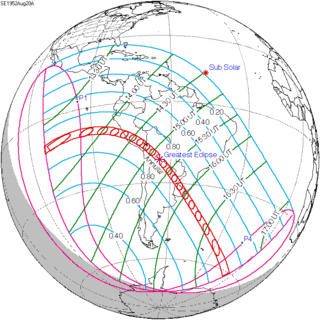
An annular solar eclipse occurred on August 20, 1952. A solar eclipse occurs when the Moon passes between Earth and the Sun, thereby totally or partly obscuring the image of the Sun for a viewer on Earth. An annular solar eclipse occurs when the Moon's apparent diameter is smaller than the Sun's, blocking most of the Sun's light and causing the Sun to look like an annulus (ring). An annular eclipse appears as a partial eclipse over a region of the Earth thousands of kilometres wide. Annularity was visible from Peru including the capital city Lima, northeastern Chile, Bolivia including the constitutional capital Sucre and seat of government La Paz, Argentina, Paraguay, southern Brazil and Uruguay.
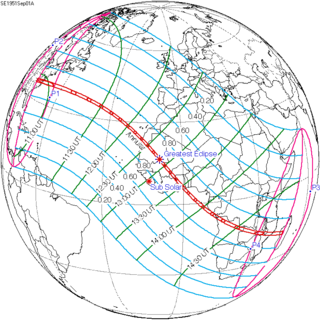
An annular solar eclipse occurred on Saturday, September 1, 1951. A solar eclipse occurs when the Moon passes between Earth and the Sun, thereby totally or partly obscuring the image of the Sun for a viewer on Earth. An annular solar eclipse occurs when the Moon's apparent diameter is smaller than the Sun's, blocking most of the Sun's light and causing the Sun to look like an annulus (ring). An annular eclipse appears as a partial eclipse over a region of the Earth thousands of kilometres wide. Annularity was visible from the United States, Spanish Sahara, French West Africa, British Gold Coast, southern tip of French Equatorial Africa, Belgian Congo, Northern Rhodesia, Portuguese Mozambique, Nyasaland, and French Madagascar.

A total solar eclipse occurred on Thursday, May 29, 1919. With the duration of totality at maximum eclipse of 6 minutes 50.75 seconds, it was the longest solar eclipse that occurred since May 27, 1416. A longer total solar eclipse would later occur on June 8, 1937. This eclipse was subject to the Eddington experiment, an observational test that first substantiated Albert Einstein's theory of relativity.
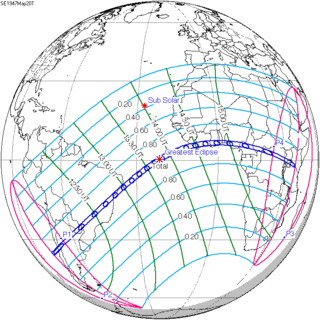
A total solar eclipse occurred on May 20, 1947. A solar eclipse occurs when the Moon passes between Earth and the Sun, thereby totally or partly obscuring the image of the Sun for a viewer on Earth. A total solar eclipse occurs when the Moon's apparent diameter is larger than the Sun's, blocking all direct sunlight, turning day into darkness. Totality occurs in a narrow path across Earth's surface, with the partial solar eclipse visible over a surrounding region thousands of kilometres wide. Totality was visible from Chile including the capital city Santiago, Argentina, Paraguay, Brazil, Liberia, French West Africa, British Gold Coast including capital Accra, French Togoland including capital Lomé, British Nigeria including capital Lagos, French Cameroons, French Equatorial Africa, Belgian Congo, British Uganda, British Tanganyika, and British Kenya. The southern part of Aconcagua, the highest mountain outside Asia, and Iguazu Falls, one of the largest waterfalls systems in the world, lie in the path of totality.

A total solar eclipse occurred on November 1, 1948. A solar eclipse occurs when the Moon passes between Earth and the Sun, thereby totally or partly obscuring the image of the Sun for a viewer on Earth. A total solar eclipse occurs when the Moon's apparent diameter is larger than the Sun's, blocking all direct sunlight, turning day into darkness. Totality occurs in a narrow path across Earth's surface, with the partial solar eclipse visible over a surrounding region thousands of kilometres wide. Totality was visible from Belgian Congo, Uganda Protectorate including the capital city Kampala, British Kenya including the capital city Nairobi, British Seychelles, and British Mauritius . During this eclipse, comet C/1948 V1, also known as the Eclipse Comet of 1948, was discovered shining near the Sun.
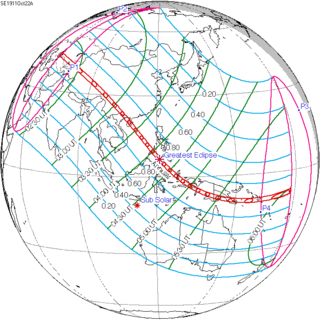
An annular solar eclipse occurred on October 22, 1911. A solar eclipse occurs when the Moon passes between Earth and the Sun, thereby totally or partly obscuring the image of the Sun for a viewer on Earth. An annular solar eclipse occurs when the Moon's apparent diameter is smaller than the Sun's, blocking most of the Sun's light and causing the Sun to look like an annulus (ring). An annular eclipse appears as a partial eclipse over a region of the Earth thousands of kilometres wide. Annularity was visible from the Russian Empire, China, French Indochina, Philippines, Dutch East Indies, Territory of Papua including the capital city Port Moresby, and British Western Pacific Territories.

An annular solar eclipse occurred on Tuesday, December 3, 1918. A solar eclipse occurs when the Moon passes between Earth and the Sun, thereby totally or partly obscuring the image of the Sun for a viewer on Earth. An annular solar eclipse occurs when the Moon's apparent diameter is smaller than the Sun's, blocking most of the Sun's light and causing the Sun to look like an annulus (ring). An annular eclipse appears as a partial eclipse over a region of the Earth thousands of kilometres wide. Annularity was visible from Chile including the capital city Santiago, Argentina including capital Buenos Aires, southern Uruguay including capital Montevideo, northeastern tip of South West Africa and southwestern Portuguese Angola. Aconcagua, the highest mountain outside Asia, also lies in the path of annularity.

A total solar eclipse occurred on Tuesday, January 25, 1944. A solar eclipse occurs when the Moon passes between Earth and the Sun, thereby totally or partly obscuring the image of the Sun for a viewer on Earth. A total solar eclipse occurs when the Moon's apparent diameter is larger than the Sun's, blocking all direct sunlight, turning day into darkness. Totality occurs in a narrow path across Earth's surface, with the partial solar eclipse visible over a surrounding region thousands of kilometres wide. Totality was visible from Peru, Brazil, British Sierra Leone, and French West Africa. At greatest eclipse, the Sun was 78 degrees above horizon.
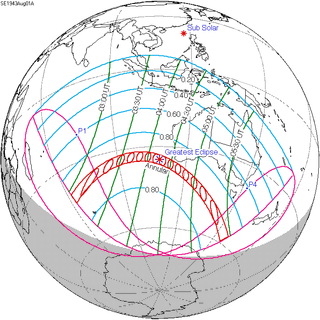
An annular solar eclipse occurred on Sunday, August 1, 1943. A solar eclipse occurs when the Moon passes between Earth and the Sun, thereby totally or partly obscuring the image of the Sun for a viewer on Earth. An annular solar eclipse occurs when the Moon's apparent diameter is smaller than the Sun's, blocking most of the Sun's light and causing the Sun to look like an annulus (ring). An annular eclipse appears as a partial eclipse over a region of the Earth thousands of kilometres wide. Annularity was visible in the southern Indian Ocean, with the only land being Île Amsterdam in French Madagascar. A partial solar eclipse was visible from Australia, Indonesia, Malaysia, eastern Madagascar, Antarctica's Wilkes Land.

An annular solar eclipse occurred on Thursday, July 20, 1944. A solar eclipse occurs when the Moon passes between Earth and the Sun, thereby totally or partly obscuring the image of the Sun for a viewer on Earth. An annular solar eclipse occurs when the Moon's apparent diameter is smaller than the Sun's, blocking most of the Sun's light and causing the Sun to look like an annulus (ring). An annular eclipse appears as a partial eclipse over a region of the Earth thousands of kilometres wide. Annularity was visible from British Uganda, Anglo-Egyptian Sudan, British Kenya, Ethiopia, British Somaliland, British Raj, Burma, Thailand, French Indochina, Philippines, South Seas Mandate in Japan the Territory of New Guinea.

An annular solar eclipse occurred on February 24, 1933. A solar eclipse occurs when the Moon passes between Earth and the Sun, thereby totally or partly obscuring the image of the Sun for a viewer on Earth. An annular solar eclipse occurs when the Moon's apparent diameter is smaller than the Sun's, blocking most of the Sun's light and causing the Sun to look like an annulus (ring). An annular eclipse appears as a partial eclipse over a region of the Earth thousands of kilometres wide. Annularity was visible from Chile, Argentina, Portuguese Angola, French Equatorial Africa, Belgian Congo, Anglo-Egyptian Sudan, Ethiopia, French Somaliland, southeastern Italian Eritrea, and Mutawakkilite Kingdom of Yemen, Aden Protectorate and Aden Province in British Raj.
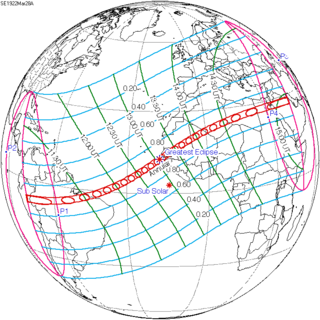
An annular solar eclipse occurred on March 28, 1922. A solar eclipse occurs when the Moon passes between Earth and the Sun, thereby totally or partly obscuring the image of the Sun for a viewer on Earth. An annular solar eclipse occurs when the Moon's apparent diameter is smaller than the Sun's, blocking most of the Sun's light and causing the Sun to look like an annulus (ring). An annular eclipse appears as a partial eclipse over a region of the Earth thousands of kilometres wide. Annularity was visible from Peru, Brazil, French West Africa, British Gambia including capital Banjul, French Algeria, Italian Libya, Egypt, Kingdom of Hejaz and Sultanate of Nejd, and British Kuwait.
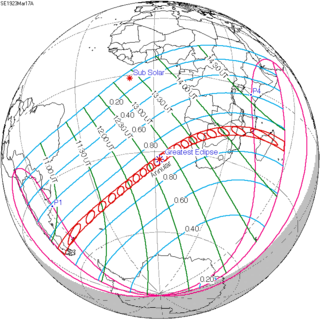
An annular solar eclipse occurred on March 17, 1923. A solar eclipse occurs when the Moon passes between Earth and the Sun, thereby totally or partly obscuring the image of the Sun for a viewer on Earth. An annular solar eclipse occurs when the Moon's apparent diameter is smaller than the Sun's, blocking most of the Sun's light and causing the Sun to look like an annulus (ring). An annular eclipse appears as a partial eclipse over a region of the Earth thousands of kilometres wide. Annularity was visible from Chile, Argentina, Falkland Islands including capital Stanley, Gough Island in Tristan da Cunha, South West Africa, Bechuanaland Protectorate (today's Botswana, Southern Rhodesia including capital Salisbury, Portuguese Mozambique, Nyasaland, French Madagascar.
